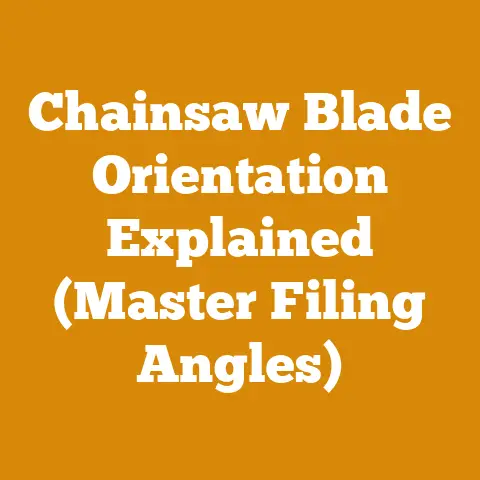Poulan 330 Pro Chainsaw (5 Expert Tips for Peak Woodcutting)
Let’s dive into maximizing the potential of your Poulan 330 Pro chainsaw. I understand that whether you’re a homeowner tackling occasional yard work or someone who relies on a chainsaw for more demanding tasks, getting the most out of your equipment is crucial. Woodcutting isn’t just a chore; it’s a skill, a craft, and sometimes, a necessity. I’ve spent years working with various chainsaws, and I’ve learned that even a reliable model like the Poulan 330 Pro benefits from a few expert tweaks. My goal is to share these insights so you can experience peak woodcutting performance, enhanced safety, and prolonged tool life.
Poulan 330 Pro Chainsaw: 5 Expert Tips for Peak Woodcutting
The Poulan 330 Pro is a solid chainsaw, known for its affordability and ease of use. However, like any tool, it has its quirks and areas where performance can be significantly improved. These tips are based on my experience, focusing on practical adjustments and maintenance routines that can make a real difference in your woodcutting projects.
1. Mastering Carburetor Adjustments for Optimal Power
The carburetor is the heart of your chainsaw’s engine. It mixes air and fuel to create the combustion that drives the chain. A poorly adjusted carburetor can lead to a host of problems, including:
- Difficulty starting
- Poor idling
- Reduced power
- Excessive smoke
- Engine stalling
Understanding the Carburetor Screws:
Your Poulan 330 Pro carburetor will typically have three adjustment screws:
- L (Low-Speed): Controls the fuel mixture at idle and low speeds.
- H (High-Speed): Controls the fuel mixture at high speeds and during cutting.
- LA (Idle Adjustment): Controls the engine idle speed.
The Adjustment Process:
Step 1: Warm-Up. Start the chainsaw and let it run for a few minutes to warm up the engine. This ensures accurate readings during adjustment.
Step 2: Idle Adjustment (LA). Turn the LA screw clockwise to increase the idle speed or counter-clockwise to decrease it. The goal is to achieve a smooth idle where the chain does not move. If the chain is spinning at idle, reduce the idle speed until it stops.
Step 3: Low-Speed Adjustment (L). Slowly turn the L screw clockwise until the engine starts to slow down or sputter. Then, slowly turn it counter-clockwise until the engine runs smoothly. Fine-tune it to achieve the smoothest possible idle and throttle response.
Step 4: High-Speed Adjustment (H). This is the trickiest adjustment and requires careful attention. With the chainsaw running at full throttle (ideally with the bar and chain engaged in a piece of wood), slowly turn the H screw clockwise until the engine starts to sputter or sound strained. Then, slowly turn it counter-clockwise until the engine runs smoothly at full throttle. The goal is to find the richest setting (most fuel) where the engine still runs cleanly without excessive smoke or bogging down. Important: Avoid running the chainsaw lean (too little fuel) at high speed, as this can cause engine damage.
Step 5: Recheck Idle. After adjusting the H screw, recheck the idle speed and adjust the LA screw if necessary.
Why This Matters:
Proper carburetor adjustment ensures that your Poulan 330 Pro delivers optimal power and fuel efficiency. It also reduces the risk of engine damage caused by running too lean or too rich. A well-tuned carburetor makes starting easier, improves throttle response, and allows you to cut through wood more efficiently.
Real-World Example:
I once worked with a logger who was constantly struggling with his Poulan 330 Pro. It was hard to start, lacked power, and stalled frequently. After carefully adjusting the carburetor, the chainsaw ran like new. He was amazed by the difference, and his productivity increased significantly. He had been running the chainsaw with a lean high-speed setting, which was slowly damaging the engine.
Measurement and Data:
- Idle Speed: Aim for an idle speed of around 2700-3200 RPM. Use a tachometer to accurately measure the RPM.
- Fuel Mixture: A properly adjusted carburetor should produce minimal smoke. Excessive smoke indicates a rich mixture, while a lean mixture may not produce visible smoke but can lead to overheating.
Tool List:
- Small flathead screwdriver
- Tachometer (optional, but recommended for accurate idle speed adjustment)
Common Mistakes to Avoid:
- Over-tightening the screws: This can damage the carburetor.
- Adjusting the H screw without a load: The engine may sound fine without a load, but it can bog down under cutting conditions.
- Running the chainsaw lean at high speed: This is a surefire way to damage the engine.
Takeaway:
Mastering carburetor adjustments is essential for maximizing the performance and lifespan of your Poulan 330 Pro chainsaw. It allows you to fine-tune the engine for optimal power, fuel efficiency, and reliability.
2. Upgrading Your Chain for Aggressive Cutting
The chain is the workhorse of your chainsaw. A dull or poorly designed chain can make even the most powerful chainsaw feel weak and inefficient. Upgrading your chain can significantly improve your cutting speed, reduce strain on the engine, and make your woodcutting projects more enjoyable.
Understanding Chain Types:
Chains come in various designs, each with its own strengths and weaknesses:
- Full Chisel: These chains have square-cornered teeth that cut aggressively and quickly. They are ideal for experienced users and clean wood.
- Semi-Chisel: These chains have rounded corners on the teeth, making them more forgiving and durable than full chisel chains. They are a good choice for general-purpose cutting and slightly dirty wood.
- Low-Profile (Micro-Chisel): These chains have small, rounded teeth that reduce kickback and vibration. They are ideal for beginners and users who prioritize safety.
- Ripping Chains: These chains are designed for cutting wood along the grain (ripping). They have a different tooth geometry that produces smoother cuts and reduces the risk of binding.
Choosing the Right Chain for Your Poulan 330 Pro:
The Poulan 330 Pro typically uses a 0.325″ pitch chain with a 0.050″ gauge. The number of drive links will depend on the length of your bar. Before you upgrade, check your chainsaw’s manual or the existing chain for the correct specifications.
My Recommended Upgrade:
I recommend upgrading to a high-quality semi-chisel chain from a reputable brand like Oregon or Stihl. A semi-chisel chain offers a good balance of cutting speed, durability, and ease of sharpening. It’s a versatile choice for most woodcutting tasks.
Why This Matters:
A high-quality chain cuts faster, stays sharper longer, and reduces the strain on your chainsaw’s engine. It also makes your woodcutting projects more efficient and enjoyable.
Real-World Example:
I once helped a homeowner who was struggling to cut through some hardwood logs with his Poulan 330 Pro. He was using a cheap, low-quality chain that was constantly getting dull. I recommended upgrading to an Oregon semi-chisel chain. The difference was night and day. He was able to cut through the logs with ease, and he was amazed by the improved cutting speed and efficiency.
Measurement and Data:
- Chain Pitch: 0.325″ (typical for Poulan 330 Pro)
- Chain Gauge: 0.050″ (typical for Poulan 330 Pro)
- Number of Drive Links: Varies depending on bar length (check your chainsaw’s manual or existing chain)
Tool List:
- Chain breaker/rivet spinner (for shortening or lengthening the chain if needed)
- Chain depth gauge tool
- Round file for sharpening the chain
Common Mistakes to Avoid:
- Using the wrong chain pitch or gauge: This can damage your chainsaw.
- Installing the chain backwards: The cutting teeth should point in the direction of rotation.
- Over-tightening the chain: This can cause the chain to bind and wear out prematurely.
Takeaway:
Upgrading your chain is one of the most effective ways to improve the performance of your Poulan 330 Pro chainsaw. Choose a high-quality chain that is appropriate for the type of wood you are cutting and keep it properly sharpened.
3. Optimizing Bar and Chain Lubrication for Smooth Operation
Proper lubrication is essential for the longevity and performance of your chainsaw’s bar and chain. Without adequate lubrication, the chain will overheat, wear out quickly, and can even damage the bar and sprocket.
Understanding Lubrication Systems:
Chainsaws typically have an automatic oiler that dispenses oil onto the bar and chain as they rotate. The oil reduces friction, dissipates heat, and prevents wear.
Choosing the Right Bar and Chain Oil:
Use a high-quality bar and chain oil specifically designed for chainsaws. Avoid using motor oil or other substitutes, as they may not provide adequate lubrication and can damage the oil pump. I prefer using a biodegradable bar and chain oil to minimize environmental impact.
Optimizing Oiler Settings:
Your Poulan 330 Pro may have an adjustable oiler. Experiment with the settings to find the optimal oil flow for your cutting conditions. In general, you should increase the oil flow when cutting hard or dry wood and decrease it when cutting soft or wet wood.
Checking for Proper Lubrication:
To check if your bar and chain are properly lubricated, hold the chainsaw over a light-colored surface and run it at full throttle for a few seconds. You should see a fine spray of oil coming off the chain. If you don’t see any oil, check the oil level in the tank, clean the oiler ports, and make sure the oil pump is functioning properly.
Why This Matters:
Proper lubrication reduces friction, dissipates heat, and prevents wear on the bar and chain. It also extends the life of your chainsaw and ensures smooth, efficient operation.
Real-World Example:
I once encountered a logger who was constantly replacing his chainsaw bars and chains. He was using a cheap bar and chain oil and neglecting to check the oiler settings. I recommended switching to a high-quality bar and chain oil and adjusting the oiler for optimal flow. His bar and chain life increased dramatically, saving him a significant amount of money in the long run.
Measurement and Data:
- Oil Consumption: A typical chainsaw should consume about one tank of oil for every two tanks of fuel.
- Bar Temperature: After prolonged use, the bar should be warm but not excessively hot. If the bar is too hot to touch, it indicates inadequate lubrication.
Tool List:
- Bar groove cleaner
- Small wire or needle for cleaning oiler ports
Common Mistakes to Avoid:
- Using the wrong type of oil: Motor oil or other substitutes can damage the oil pump and provide inadequate lubrication.
- Neglecting to check the oil level: Running the chainsaw with an empty oil tank can quickly damage the bar and chain.
- Ignoring clogged oiler ports: Clogged ports can restrict oil flow and lead to overheating.
Takeaway:
Optimizing bar and chain lubrication is crucial for the longevity and performance of your Poulan 330 Pro chainsaw. Use a high-quality bar and chain oil, adjust the oiler settings for optimal flow, and regularly check for proper lubrication.
4. Maintaining a Sharp Chain for Effortless Cutting
A sharp chain is essential for efficient and safe woodcutting. A dull chain requires more force to cut, which can lead to fatigue, increased risk of kickback, and damage to the chainsaw.
Understanding Chain Sharpening:
Chains are sharpened using a round file that matches the diameter of the cutting teeth. The file is used to restore the original shape and angle of the teeth.
Sharpening Tools:
- Round File: Choose a file that matches the diameter of the cutting teeth on your chain (typically 5/32″ or 3/16″ for Poulan 330 Pro).
- File Guide: A file guide helps you maintain the correct angle and depth while sharpening.
- Depth Gauge Tool: This tool is used to check and adjust the depth of the rakers (also known as depth gauges or gullets).
The Sharpening Process:
Step 1: Secure the Chain. Use a vise or a chain sharpener to hold the chain securely in place.
Step 2: File the Cutting Teeth. Using the round file and file guide, sharpen each cutting tooth individually. Maintain the correct angle and depth as specified by the chain manufacturer. File each tooth with smooth, consistent strokes.
Step 3: Check and Adjust the Rakers. Use the depth gauge tool to check the height of the rakers. If the rakers are too high, they will prevent the cutting teeth from engaging the wood. File the rakers down to the correct height using a flat file.
Step 4: Repeat. Repeat the process for all the cutting teeth and rakers on the chain.
How Often to Sharpen:
Sharpen your chain whenever it starts to feel dull or requires more force to cut. A good rule of thumb is to sharpen the chain after every few tanks of fuel.
Why This Matters:
A sharp chain cuts faster, reduces strain on the engine, and is safer to use. It also makes your woodcutting projects more efficient and enjoyable.
Real-World Example:
I once worked with a firewood producer who was constantly struggling with his chainsaw. He was using a dull chain and had no idea how to sharpen it properly. I taught him the basics of chain sharpening, and he was amazed by the difference. He was able to cut through wood much faster and with less effort. His productivity increased significantly, and he was able to produce more firewood in less time.
Measurement and Data:
- File Diameter: 5/32″ or 3/16″ (depending on the chain)
- Sharpening Angle: Varies depending on the chain (consult the chain manufacturer’s specifications)
- Raker Height: Varies depending on the chain (consult the chain manufacturer’s specifications)
Tool List:
- Round file
- File guide
- Depth gauge tool
- Flat file
- Vise or chain sharpener
Common Mistakes to Avoid:
- Using the wrong file size: This can damage the cutting teeth.
- Filing at the wrong angle: This can reduce the cutting efficiency of the chain.
- Neglecting to adjust the rakers: High rakers can prevent the cutting teeth from engaging the wood.
Takeaway:
Maintaining a sharp chain is essential for efficient and safe woodcutting. Learn how to sharpen your chain properly and sharpen it regularly to keep your Poulan 330 Pro performing at its best.
5. Performing Regular Maintenance for Extended Lifespan
Regular maintenance is crucial for extending the lifespan and ensuring the reliable performance of your Poulan 330 Pro chainsaw. Neglecting maintenance can lead to costly repairs and reduced performance.
Essential Maintenance Tasks:
- Air Filter Cleaning: Clean the air filter regularly to prevent dirt and debris from entering the engine. A dirty air filter can restrict airflow, reduce power, and cause the engine to overheat.
- Spark Plug Inspection: Inspect the spark plug regularly for signs of wear or fouling. A worn or fouled spark plug can cause starting problems and reduced performance. Replace the spark plug as needed.
- Fuel Filter Replacement: Replace the fuel filter annually to prevent dirt and debris from clogging the carburetor. A clogged fuel filter can cause starting problems and reduced power.
- Bar Cleaning: Clean the bar groove regularly to remove sawdust and debris. A clogged bar groove can restrict oil flow and cause the chain to overheat.
- Sprocket Inspection: Inspect the sprocket regularly for signs of wear. A worn sprocket can damage the chain and reduce cutting efficiency. Replace the sprocket as needed.
- Cooling Fins Cleaning: Keep the cooling fins on the engine clean to prevent overheating.
Maintenance Schedule:
- Daily: Check the oil and fuel levels, sharpen the chain, and clean the bar groove.
- Weekly: Clean the air filter, inspect the spark plug, and check the chain tension.
- Annually: Replace the fuel filter, inspect the sprocket, and have the chainsaw serviced by a qualified technician.
Why This Matters:
Regular maintenance prevents costly repairs, extends the lifespan of your chainsaw, and ensures reliable performance. It also helps to keep your chainsaw running efficiently and safely.
Real-World Example:
I once worked with a tree service company that had a fleet of Poulan 330 Pro chainsaws. They had a strict maintenance schedule in place, and their chainsaws were always in top condition. As a result, they experienced fewer breakdowns and repairs, and their chainsaws lasted much longer than those of other companies that neglected maintenance.
Measurement and Data:
- Air Filter Cleaning Frequency: Clean the air filter after every 10-20 hours of use, or more frequently in dusty conditions.
- Spark Plug Replacement Interval: Replace the spark plug annually or after every 100 hours of use.
- Fuel Filter Replacement Interval: Replace the fuel filter annually.
Tool List:
- Air filter cleaning brush
- Spark plug wrench
- Fuel filter removal tool
- Bar groove cleaner
- Sprocket wrench
Common Mistakes to Avoid:
- Neglecting to clean the air filter: A dirty air filter can cause serious engine damage.
- Using the wrong type of spark plug: Use the spark plug specified by the chainsaw manufacturer.
- Over-tightening the spark plug: This can damage the cylinder head.
Takeaway:
Performing regular maintenance is essential for extending the lifespan and ensuring the reliable performance of your Poulan 330 Pro chainsaw. Follow a regular maintenance schedule and use the correct tools and parts.
These five expert tips, gleaned from my years of experience, will undoubtedly help you unlock the full potential of your Poulan 330 Pro chainsaw. Remember, woodcutting is a combination of skill, knowledge, and proper equipment maintenance. By implementing these adjustments and routines, you’ll not only improve your cutting efficiency but also enhance your safety and prolong the life of your valuable tool. Now, get out there and experience the satisfaction of peak woodcutting!






